|

 Up
Up 
 Pilots,
Pilots,
Planes
and Pioneers

(You are here.)
 Down
Down




  Need
to Need
to
find your
bearings?
Try
these
navigation aids:
If
this is your first
visit, please stop by:
Something
to share?
Please:



|
|
Available in Française, Español, Português, Deutsch, Россию,
中文,
日本, and others.
 hile
the Wright brothers may have been the first to make a sustained,
controlled flight, they were just two among hundreds of brave men
and women who helped to give the world its wings during the earliest
days of aviation. Their Flyer was but one of many historically
important aircraft. Below are brief descriptions and photos of some
of the most important people and planes, and where available
resources and links where you can find more information. In some
cases, contributors have supplied expanded
histories and biographies. Those are listed at the right and linked below. hile
the Wright brothers may have been the first to make a sustained,
controlled flight, they were just two among hundreds of brave men
and women who helped to give the world its wings during the earliest
days of aviation. Their Flyer was but one of many historically
important aircraft. Below are brief descriptions and photos of some
of the most important people and planes, and where available
resources and links where you can find more information. In some
cases, contributors have supplied expanded
histories and biographies. Those are listed at the right and linked below.
A
 B
B
 C
C
 D
D
 E
E
 F
F
 G
G
 H
H
 I
I
 J
J
 K
K
 L
L
 M
M
N
 O
O
 P
P
 Q
Q
 R
R
 S
S
 T
T
 U
U
 V
V
 W
W
 X
X
 Y
Y
 Z
Z
|
|
 |
|
|
William Tate was the
postmaster at Kitty Hawk who, along with weather station chief John Dosher,
responded to Wilbur Wright's 1900 inquiry about the suitability of Kitty
Hawk for gliding experiments. Tate's friendly reply decided the Wright
brothers to travel to the North Carolina Outerbanks and began a friendship
that lasted a lifetime. In the years after the Wright brothers experiments
at Kitty Hawk, Tate was a tireless supporter of the Wrights and in 1928
helped erect the first monument to the Wright brothers in America. This
small stone obelisk stands near the spot that was once the Tate's front
yard where Wilbur began building his first man-carrying glider in 1900. |

Captain William Tate, his wife Abbie, their daughters, and a friend
on the porch of the Kitty Hawk Post Office.
|
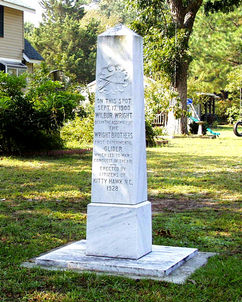
Tate raised $200 to have this monument made and placed in front of
the Post Office, marking the spot where Wilbur assembled his first
glider.
|
 |
Charles E. Taylor,
better known as Charlie Taylor, was born in Illinois in 1868 and grew up in
Nebraska. He ran a machine shop for a short time in Omaha, but had to shut
it down for lack of work. Shortly thereafter, he became engaged to
Henrietta Webbert in nearby Kearney. The Webberts were members of the
Church of the United Brethren who had once lived in Dayton, Ohio. Just
before Charley and Henrietta married in 1894, Bishop Milton Wright visited
the Webberts and suggested to Henrietta that she and her husband-to-be
move to Dayton where there was more work for a machinist. Charlie finally
took the Bishop's advice in 1896, moving to Dayton just after the birth of
his first son. He worked for the Stoddard Manufacturing Company at first,
making engines, bicycles, and farm machinery. He quit in 1898 to set up a
machine shop with a partner. One of their clients was the Wright Cycle
Company, who had them machine the parts of a new coaster brake they had
invented. Charlie and his partner sold their shop at a good profit after a
few years and both moved on to to other jobs. Charlie went to work for the
Wright brothers in the summer of 1901 and helped run the shop during their long
absences at Kitty Hawk, NC. They relied on him for most of the machine
work when they built their first aircraft engines in 1903, and he assisted
them in their experiments at Huffman Prairie in 1904 and 1905. In 1907, he
traveled to France with them when they thought they might have to assemble
and demonstrate an airplane, and in 1908 and 1909, he assisted at the
trials of the Wright Military Flyer, the U.S. Army's first military
aircraft at Fort Meyer, VA. and finally flew with Orville Wright in 1910.
He was foreman of the machining department in the Wright Company, the
business the Wrights set up to manufacture airplanes. Owing to company politics,
Charlie decided to leave in 1911 and followed Cal Rodgers across the United
States as chief mechanic for the Vin Fiz, the first airplane to
make a transcontinental flight. He stayed in California for a short time,
then came back to Dayton at Orville's invitation and helped him restore
the 1903 Flyer in 1916 for an exhibition at the Massachusetts Institute of
Technology. He continued to work with Orville at his laboratory
until 1928, then returned to California. There he made an unfortunate real
estate investment that would plague him for the remainder of his life.
Charlie kept in touch with Orville,
corresponding about minor inventions while he scrounged for
machinist's jobs. In 1936, he was hired by the North American Aviation
Company in Inglewood, California. He resigned after less than a year and
went to work for Henry Ford's Edison Institute to help restore the Wright
brothers bicycle shop and Greenfield Village. He left Dearborn for
California in 1942, was an honorary pallbearer at Orville's funeral in
1948, and died in Los Angeles in 1956. Charlie's remains were interred in the
Portal of the Folded Wings in Burbank, California
along with two other Wright associates, Walter Brookins and Roy
Knabenshue..
|
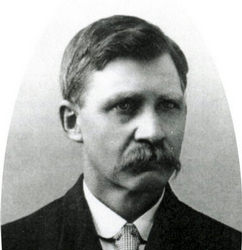
Charles Edward Taylor, about the time he went to work for the Wright
brothers.
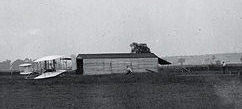
The first launch of the 1905 Flyer III in June 1905, with Charlie at
the far right. Charlie always manned a backup stopwatch during these
flights. The prime stopwatch was operated by whichever brother
wasn't flying.
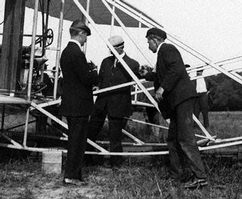
Orville (left), Charlie Furnas (middle), and Charlie Taylor (right)
consult before a flight at Fort Myer in 1908.

Charlie (left) talks to Cal Rodgers (right) about one of the many
repairs that had to be made to keep the
Vin Fiz airworthy.
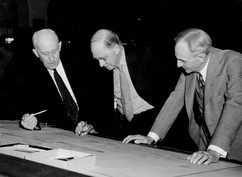
Orville (left), Charlie (middle), and Henry Ford (right) looking
over plans for the installation of the Wright bicycle shop at
Greenfield Village in 1938.
|
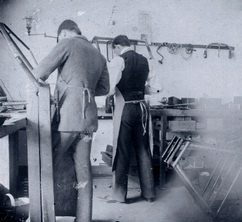
Charlie working with Orville in the bike shop, about 1901.

Wilbur greets Charlie when they meet in France in 1907. The trip
turned out to be for nought.
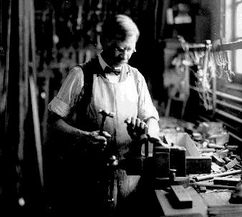
Charlie at work at the Wright Company factory circa 1911.
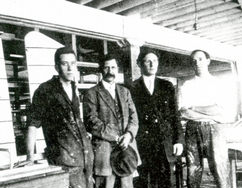
Charlie (second from the left) with some other employees at Glenn
Martin's factory in 1912.
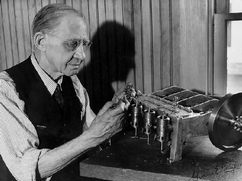
Charlie in 1947 with a 1/2-scale model of the 1903 Wright engine
that he made at Greenfield Village.
|
 |
Felix du Temple, a French seaman, built
a model airplane in 1857 which made the first powered flight in
history. Driven by a clockwork motor, it took off under its own power,
sustained itself in the air, and glided to a safe landing. In 1858, Du
Temple refit his model with a steam engine. He patented his design and
began work on a man-carrying version on his aircraft. In 1874, this made a
ski-jump take-off piloted by a young sailor. It was the first powered
aircraft to leave the ground with a person aboard, but it could not
sustain flight and landed after a short distance.
|
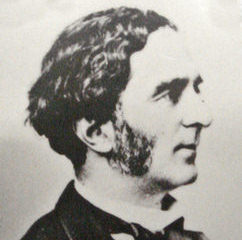
Felix de la Croix du Temple.
|

Drawings of the steam powered monoplane with which du Temple made
the first recorded attempt at powered flight in 1874.
|
 |
|
|
|

